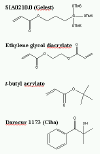|
|
|
|
Etch Barrier The etch barrier material is subject to several design constraints, some of which are summarized in Figure 1. The etch barrier liquid must be dispensable from an automatic fluid dispense system, and must not change significantly in composition between dispensing and imprinting by, e.g., component evaporation. It must be readily displaced during the imprint step and photopolymerize rapidly during exposure. Shrinkage due to polymerization must be controlled. The polymer must release from the template while adhering to the transfer layer, and it must exhibit sufficient rigidity to avoid feature collapse It must exhibit some level of temperature stability to withstand the etching temperatures, and it must exhibit sufficient etch selectivity during the O2 RIE step to allow for high aspect ratios to be generated in the transfer layer.
Figure 1. Summary of some etch barrier requirements. The SFIL process relies on photopolymerization of a low viscosity, acrylate-based solution. Acrylate polymerization is known to be accompanied by volumetric shrinkage that is the result of chemical bond formation. Consequently, the size, shape, and placement of the replicated features may be affected. Volumetric shrinkage was found to be less than 10% (v/v) in most cases.1,2 Finite element modeling (FEM) results indicate that no significant pattern placement distortion will result as a consequence of densification. Additionally, the sidewall angle is predicted to be close to 90° for high aspect ratio features, and will approach 80° for low aspect ratio features, using the worst-case model parameter of 17% (v/v) densification.1,2 In separate studies of various acrylate and methacrylate monomers, the effect of fluence was examined using IR to follow the isolated C=C stretching absorbance peak at 1640 cm-1 and revealed nearly complete conversion with less than 30 mJ/cm2.3 Further information on UV curing of acrylate coatings can be found in works by Decker4 and Kloosterboer.5-7 The current etch barrier liquid is a multicomponent solution. The silylated monomer provides etch resistance in the O2 transfer etch. Crosslinker monomers provide thermal stability to the cured etch barrier and also improve the cohesive strength of the etch barrier. Organic monomers serve as mass-persistent components and lower the viscosity of the etch barrier formulation. The photoinitiators dissociate to form radicals upon UV irradiation, and these radicals initiate polymerization. The current formulation includes the monomers whose structures are shown in Figure 2.
Figure 2. Chemical structures of current etch barrier monomers.
| |
|
|
|


